BIOLOGÍA
1/40
Earn XP
Description and Tags
Name | Mastery | Learn | Test | Matching | Spaced |
|---|
No study sessions yet.
41 Terms
Teoría del big bang
Explica el origen del
universo (entendido como…)
espacio-tiempo
Tierra primigenia se formó por…
la colisión
y fusión de fragmentos de rocas más
pequeños
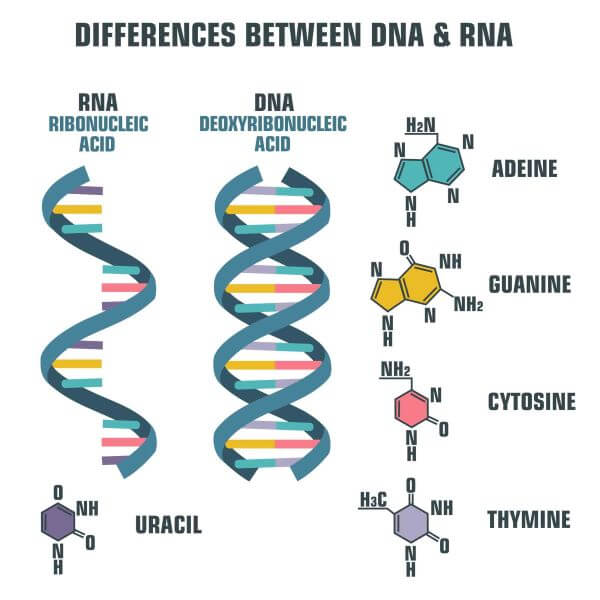
es una evolución que comprenden el cambiar
compuestos inorgánicos simples por
compuestos orgánicos complejos. Como
resultado, la química de los océanos y de la
atmósfera cambió con el paso del tiempo,
enriqueciéndose lo suficiente como para
propiciar la aparición de la vida.
Evolución química
La Tierra que conocemos tiene un aspecto
muy distinto del que tenía poco después de
su nacimiento, hace unos…
4.600 millones de años
La atmósfera primitiva contenía
Dióxido de Carbono (CO2)
Monóxido de Carbono (CO)
• Vapor de Agua (H2O)
• Hidrógeno (H)
• Nitrógeno (N2)
También es posible que hubiera Amoníaco
(NH3), Sulfuro de Hidrógeno (H2S) y
Metano (CH4). Es probable que tuviera
poco o nada de oxígeno (O2).
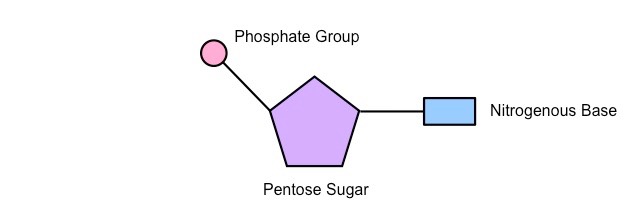
las
cianobacterias habían producido suficiente
oxígeno para modificar la atmósfera
terrestre. Muchos anaerobios obligados
(aquellos que no viven en presencia de
oxígeno) fueron dañados por el oxígeno
Aparición de los AEROBIOS
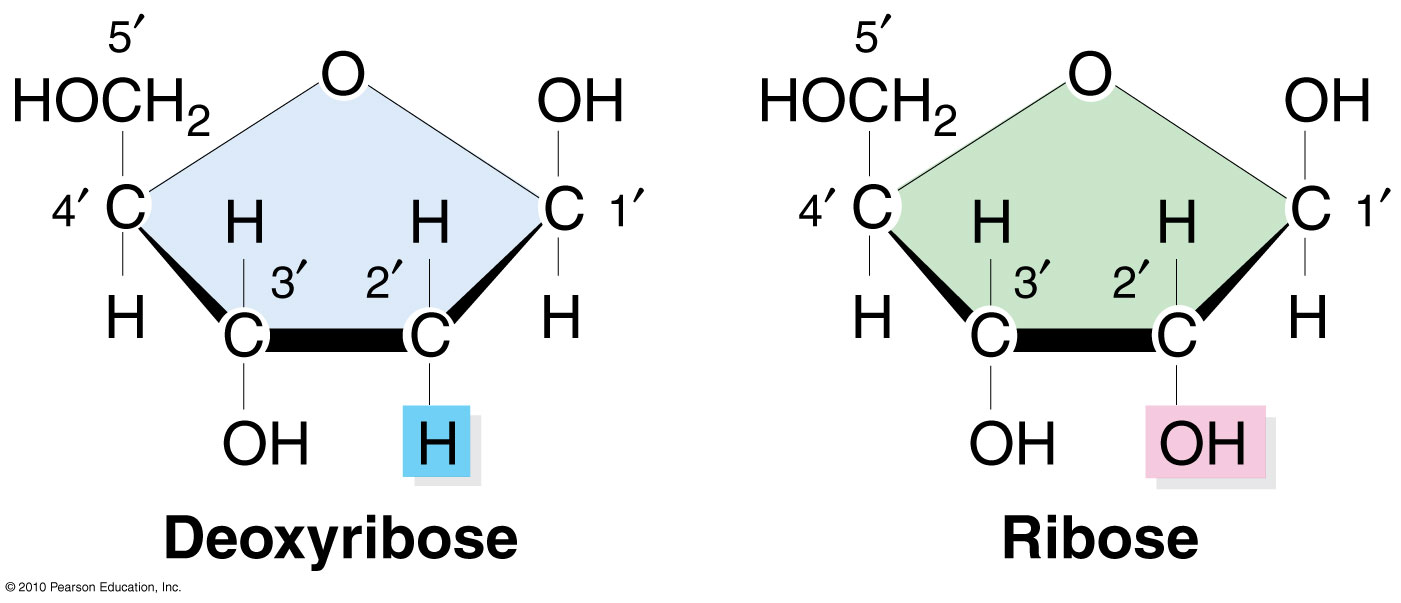
nos dan información acerca de
la evolución de la vida sobre la Tierra,
características morfológicas para su
clasificación, la interacción de los
organismos entre ellos y con el ambiente,
sus hábitos y además, algunos son de gran
importancia para la subdivisión del tiempo
geológico.
Restos fósiles
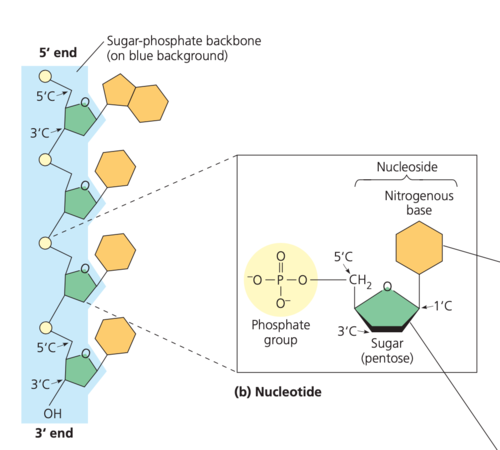
esta diferencia de
habilidades causa que ciertos individuos
tengan más oportunidades de dejar hijos que
otros. A esto le llamamos selección natural.
Dos de los mecanismos más importantes que
se aceptan actualmente son la…
deriva
genética y la selección artificial
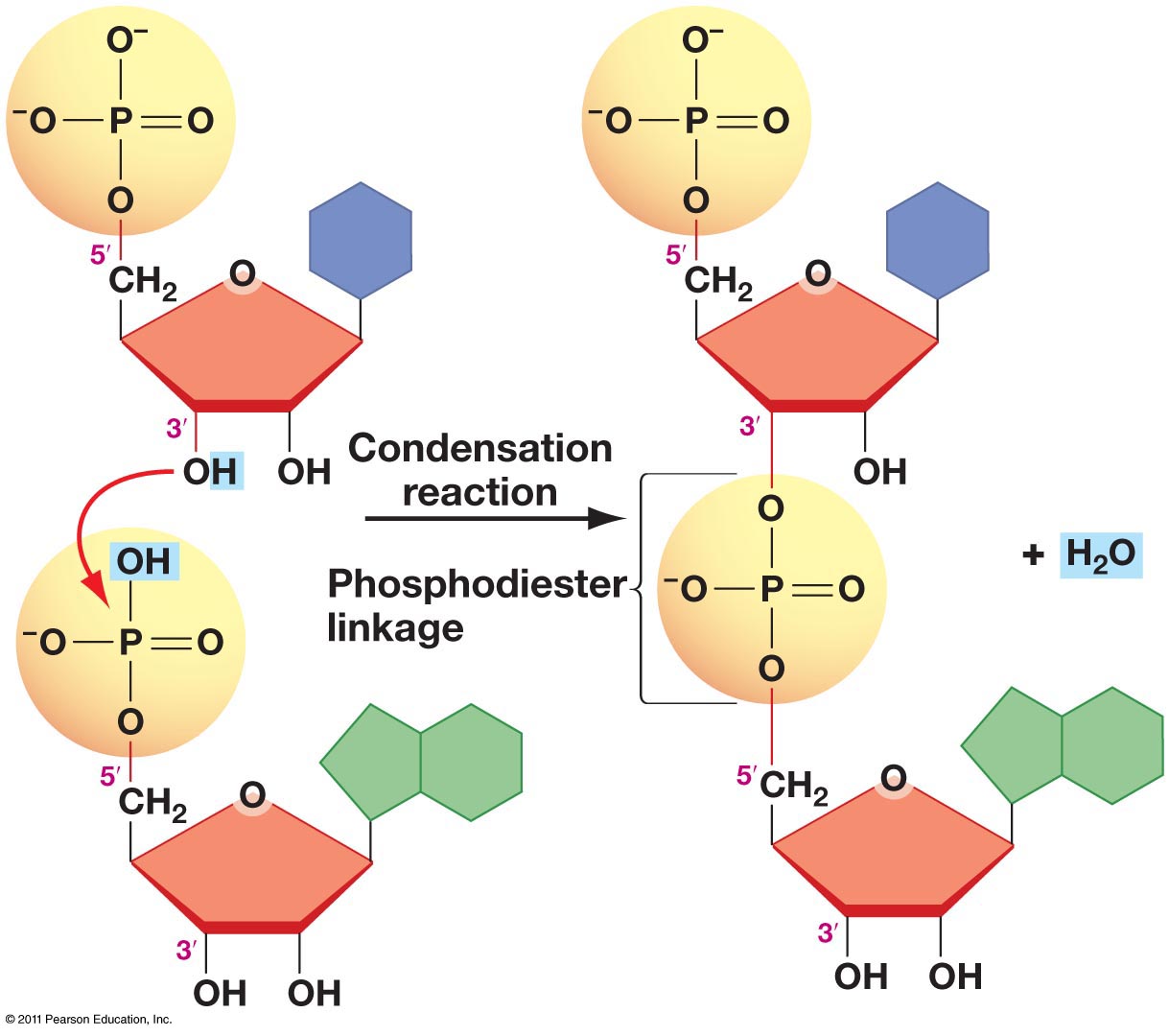
fomentamos su reproducción para que la
siguiente generación tenga estas mismas
características.
SELECCIÓN ARTIFICIAL
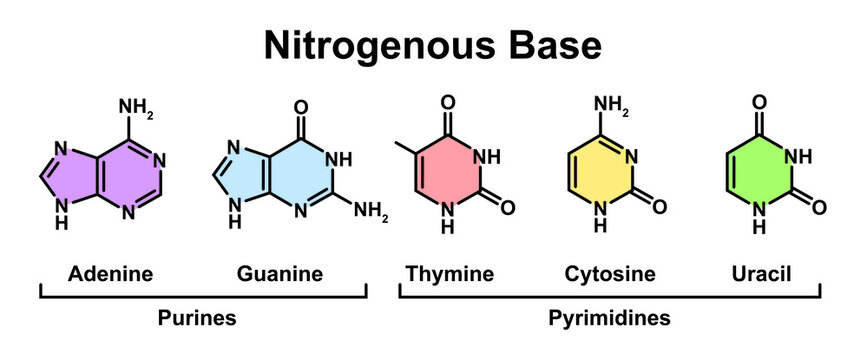
idea de que, por el simple azar, algunos
individuos tienen más oportunidades de
transmitir sus genes que otros.
LA DERIVA GENÉTICA
Es cuando se produce un suceso natural que separa a una población
de forma permanente, los efectos de las
mutaciones y la selección natural darán lugar
a variaciones que terminarán por
diferenciarlas por completo.
ESPECIACIÓN ALOPÁTRICA
una población se separa debido a la
explotación de nichos ecológicos diferentes,
dentro de un mismo ambiente,
Especiación simpátrica
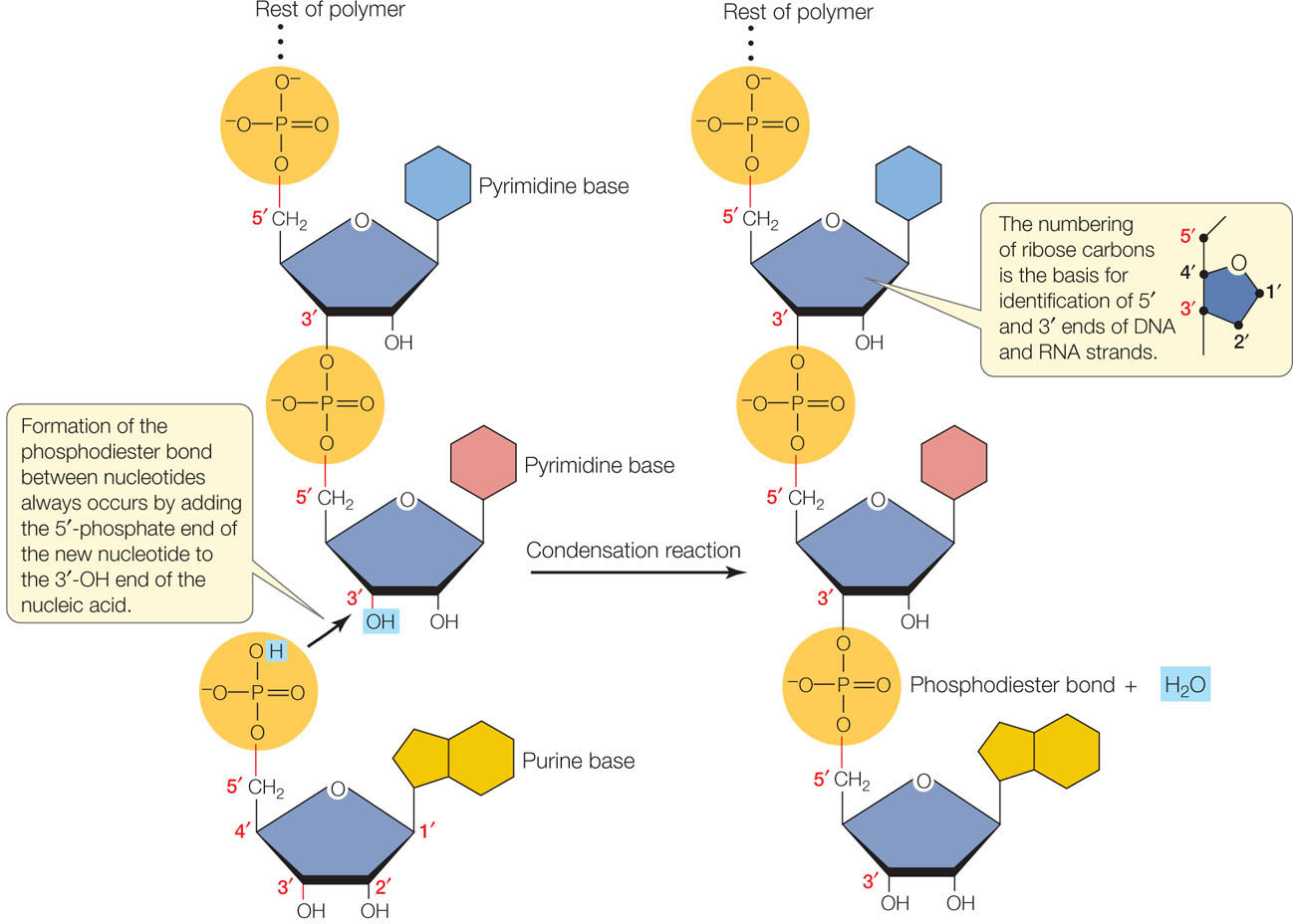
Equilibrio ecológico
El mantenimiento del equilibrio de un
ecosistema depende de tres factores:
• La energía disponible
• Las condiciones del medio ambiente
• Las interacciones entre las especies..
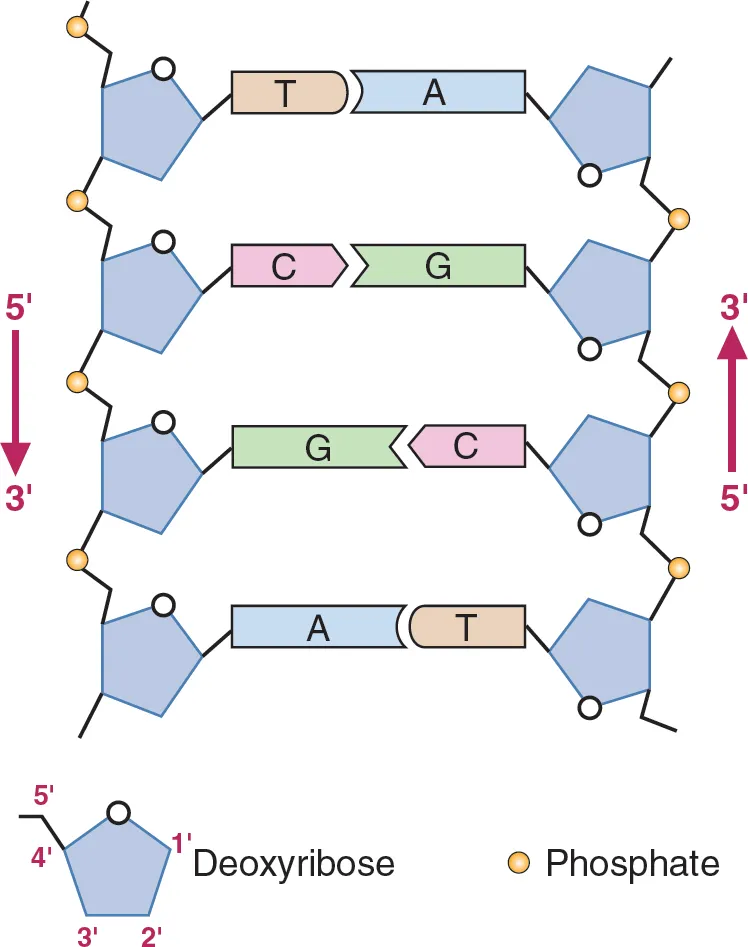
Tipos de energía renovable
Energía solar
Energía eólica
Energía hidroeléctrica
Energía de Biomasa
Biogás
Energía del mar
Energía geotérmica
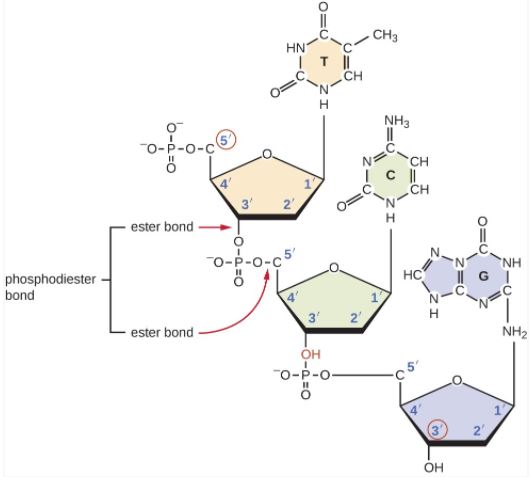
es una energía alternativa producida
biodegradando materia orgánica, mediante
microorganismos, en dispositivos específicos
sin oxígeno
Biogás
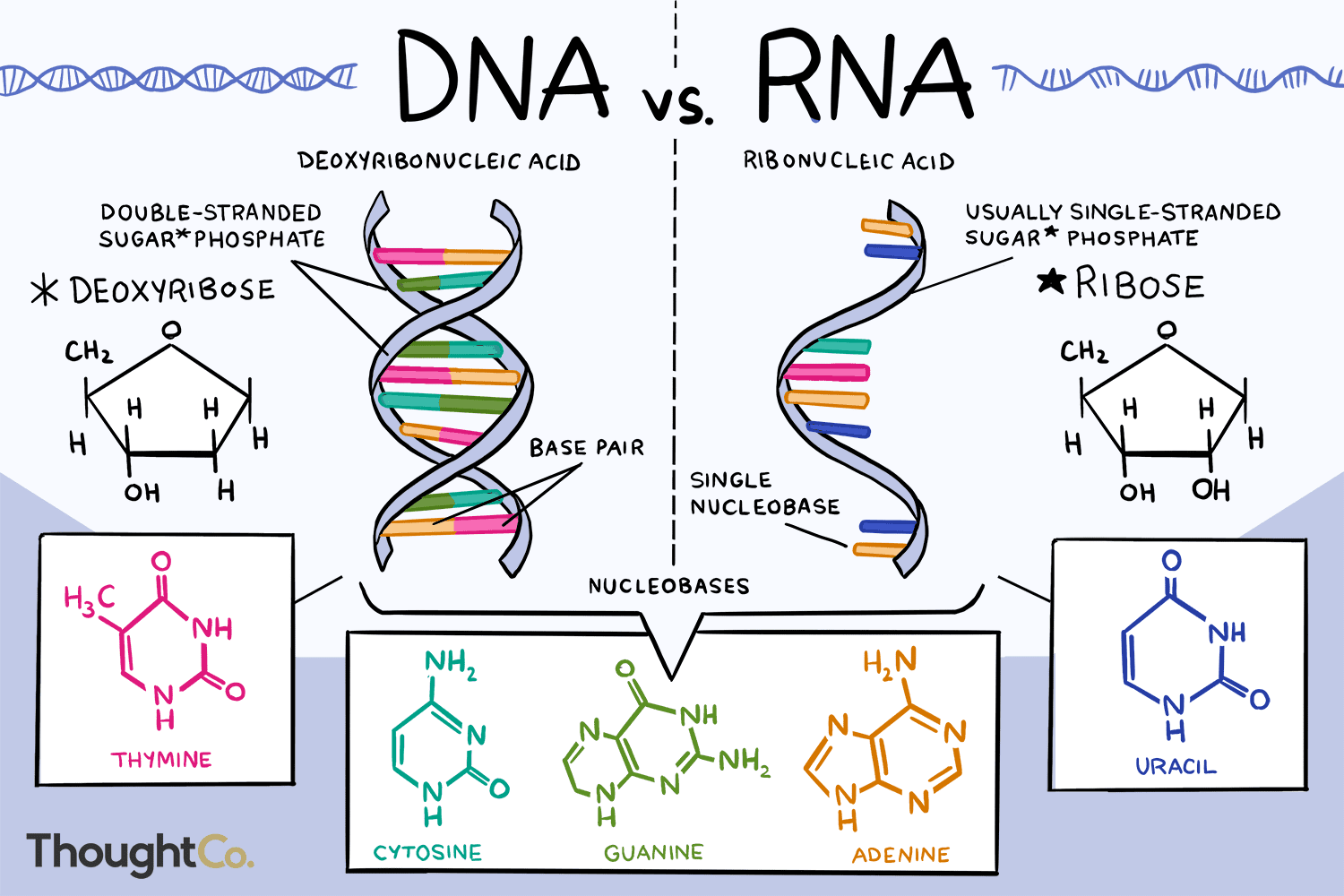
Esta energía alternativa es una de las formas
más económicas y ecológicas de generar
energía eléctrica en una central térmica
Energía de biomasa
Energía alternativa que nace en el corazón de
la tierra,aprovecha las altas temperaturas de
yacimientos bajo la superficie terrestre
(normalmente volcánicos) para la generación
de energía a través del calor, pues suelen
encontrarse a 100 o 150 grados centígrados.
Energía geotérmica
Estructura que
establece el
límite de la
célula. En su
superficie los
glúcidos se
unen a
proteínas o
lípidos
formando
glucoproteínas
o glucolípidos.
Membrana celular
Outline the role of complementary base pairing in transmitting the genetic code in transcription.
A1.2.8— Role of complementary base pairing in allowing genetic information to be replicated and expressed.
During transcription, one of the the two strands of a DNA molecule is used as a template for the creation of an RNA strand. Because of the base pairing rule, the DNA template strand will always code for the complementary sequence of RNA nucleotides in the (A to U, C to G). The complementary base paring will maintain the sequence of the gene as mRNA is translated into protein.
Outline the role of complementary base pairing in transmitting the genetic code in translation.
A1.2.8— Role of complementary base pairing in allowing genetic information to be replicated and expressed.
During translation, an RNA strand is used as a template for the creation of a polypeptide. Because of the base pairing rule, the mRNA codon will only bind with the complementary tRNA anticodon (A to U, C to G). The complementary base paring ensures the correct amino acid are brought in the correct sequence to the ribosome.
Outline why there is a limitless diversity of DNA base sequences.
A1.2.9— Diversity of possible DNA base sequences and the limitless capacity of DNA for storing Information.
There are four nitrogenous bases in DNA (A, T, C and G). These 4 bases are components of nucleotides that can form a DNA molecule in any order and of any length.
Define universal in relation to the genetic code.
A1.2.10— Conservation of the genetic code across all life forms as evidence of universal common ancestry.
Universal means that the characteristic is shared by all life.
A universal generic code means that all life uses essentially the same code when translating information stored in genes into a polypeptide.
Outline why conservation of the genetic code across all forms of life is evidence of common ancestry.
A1.2.10— Conservation of the genetic code across all life forms as evidence of universal common ancestry.
Using inductive reasoning, it can be concluded that the use of the same genetic code across all forms of life indicates that all organisms inherited the use of the code from a common ancestor. The alternative, that all forms of life independently developed use of the same genetic code, is an illogical hypothesis.
Identify and label the 5’ and 3’ ends on a DNA or RNA diagram.
AHL A1.2.11— Directionality of RNA and DNA.
Each end of DNA nucleotide has a number. One end is referred to as 5' (five prime) and the other end is referred to as 3' (three prime). The 5' and 3' designations refer to the number of the carbon atom in a deoxyribose sugar molecule. The 5' end is identified by the presence of the phosphate group and the 3' end is identified as ending in the pentose sugar (ribose or deoxyribose).
In DNA, one strand will run from 5' to 3' and the complementary strand will run anti-parallel, from 3' to 5'.
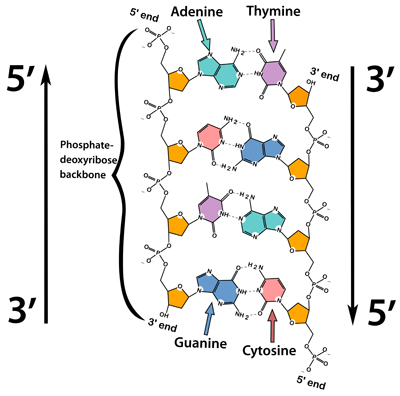
Compare and contrast the structures of purines and pyrimidines.
AHL A1.2.12— Purine-to-pyrimidine bonding as a component of DNA helix stability.
Both purines and pyrimidines are nitrogenous bases of DNA and RNA.
Pyrimidine: single ring nitrogenous bases
Cytosine
Thymine
Uracil
Purine: double ring nitrogenous bases
Guanine
Adenine
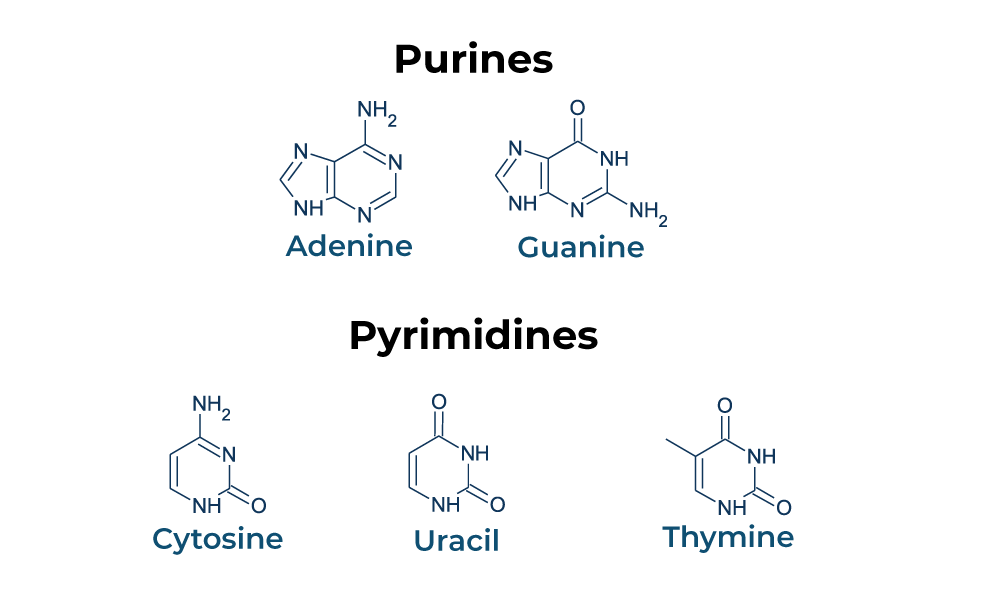
State that in DNA, a purine forms hydrogen bonds with a pyrimidine.
AHL A1.2.12— Purine-to-pyrimidine bonding as a component of DNA helix stability.
In DNA, a purine complementary base pairs to a pyrimidine using hydrogen bonds
In DNA and RNA, guanine bonds with cytosine with three hydrogen bonds.
In DNA, adenine bonds with thymine with two hydrogen bonds.
In RNA, adenine bonds with uracil with two hydrogen bonds
Given a diagram of DNA, identify the four bases of DNA based on purine or pyrimidine and the number of hydrogen bonds.
AHL A1.2.12— Purine-to-pyrimidine bonding as a component of DNA helix stability.
Purines have two rings. If it can form 2 H-bonds it is adenine and if it can form 3 H-bonds it is guanine.
Pyrimidines have one ring. If it can form 2 H-bonds it is thymine and if it can form 3 H-bonds it is cytosine.
Describe the structure of eukaryotic DNA and associated histone proteins during interphase (chromatin).
AHL A1.2.13— Structure of a nucleosome.
To compact DNA while regulating gene accessibility for transcription, eukaryotic organisms organize their genomes:
1. DNA double helix.
2. DNA wraps around histone proteins, forming nucleosomes and the "beads on a string" structure.
3. Multiple nucleosomes wrap into a fibre (chromatin).
4. Supercoiling of the chromatin produces the chromosome (during mitosis and meiosis). Supercoiling refers to the repeated twisting and winding of the DNA strand. Supercoiling functions to reduce the space required for DNA packaging, allowing for more compact storage of DNA.
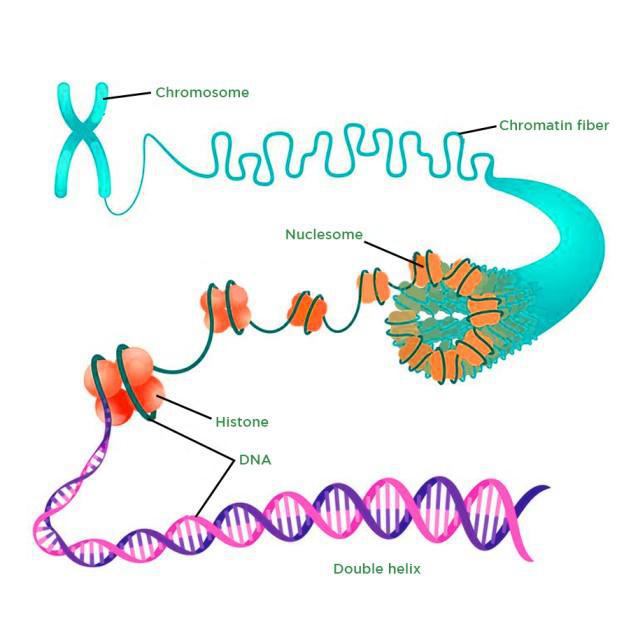
Draw and label the structure of a nucleosome, including the H1 protein, the octamer core proteins, linker DNA and two wraps of DNA.
AHL A1.2.13— Structure of a nucleosome.
The nucleosome is the basic unit of DNA packaging in eukaryotes. Each nucleosome is composed of two turns of DNA wrapped around a group of eight histone proteins (called an octamer core). Each nucleosome connects to the adjacent nucleosomes through another type of histone protein (called the H1) and a region of "linker" DNA.
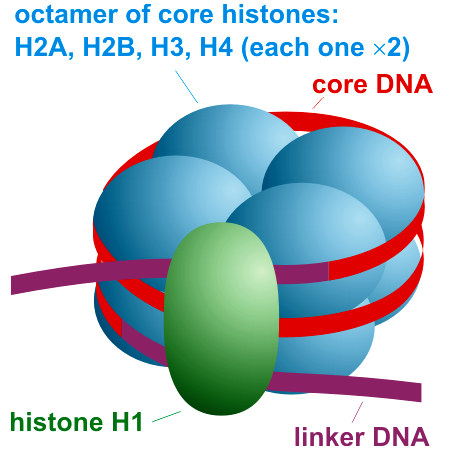
Define a histone.
AHL A1.2.13— Structure of a nucleosome.
Histone: a protein molecule around which DNA is tightly coiled. There are two of each kind of histone in a nucleosome.
Define a nucleosome.
AHL A1.2.13— Structure of a nucleosome.
Nucleosome: Linker DNA coiled twice around eight histone proteins. DNA is attracted to the histones because DNA is negatively charged and the histones are positively charged
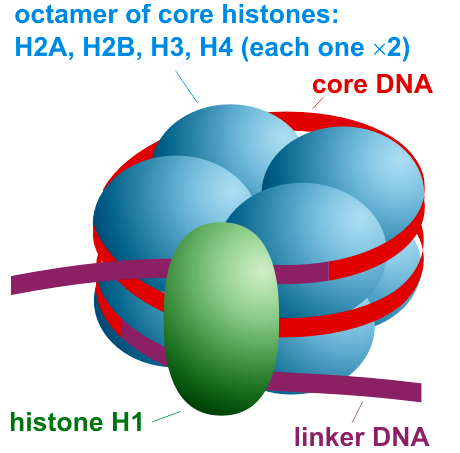
Distinguish between exons and introns
AHL A1.2.13— Structure of a nucleosome.
Exons: fragments that code for proteins
Introns: non-coding fragments
Define a pseudogene.
AHL A1.2.13— Structure of a nucleosome.
Pseudogene: sections of DNA that don’t appear to have a coding function
Define a polymorphism.
AHL A1.2.13— Structure of a nucleosome.
Polyphormism: specific regions of DNA that show significant variation between people
Outline the significance of DNA packaging.
AHL A1.2.13— Structure of a nucleosome.
DNA packaging is essential because the nucleus is microscopic, so DNA is paired with a type of protein called a histone.
DNA is inaccessible to transcription enzymes when wrapped around histones & in even more elaborate structures. This regulates the transcription process, allowing only certain areas of the DNA molecule to be involved in protein synthesis.
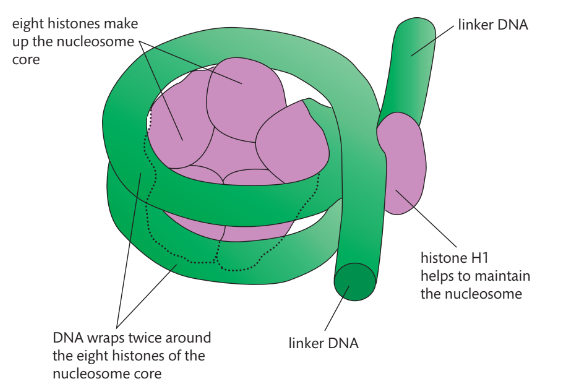
Define DNA profiling.
AHL A1.2.13— Structure of a nucleosome.
DNA Profiling: A procedure that analyzes DNA fragments to determine whether they come from a specific individual
Define a loci.
AHL A1.2.13— Structure of a nucleosome.
Loci: Location of a gene on a chromosome
List the types of DNA sequences.
AHL A1.2.13— Structure of a nucleosome.
Highly repetitive Sequences (45%): Groups of repetitive DNA that do not have coding functions and are transposable (can move from one genome location to another)
Protein-coding Genes (2%): Single-copy genes that have coding functions
Structural DNA (20%): Highly coiled DNA that does not have a coding function; occurs around the centromere & near the ends of chromosomes at the telomeres
Short Tandem Repeats: a group of 13 very specific loci that are short, repeating sequences of DNA (normally 2-5 base pairs)
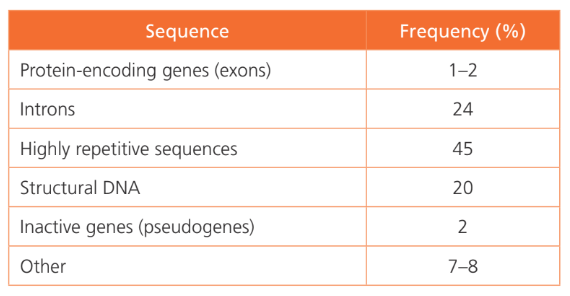
State the experimental question being tested in the Hershey and Chase experiment.
AHL A1.2.14— Evidence from the Hershey–Chase experiment for DNA as the genetic material.
Both protein and nucleic acids are part of the eukaryotic cell nucleus. Prior to 1952 it was unknown which molecule type was responsible for passing genetic information between generations.
Hershey and Chase designed an experiment to test whether proteins or DNA is the hereditary material.
Outline the procedure of the Hershey and Chase experiment.
AHL A1.2.14— Evidence from the Hershey–Chase experiment for DNA as the genetic material.
Hershey and Chase (H&C) performed their experiments on viruses that infect bacteria called bacteriophages.
They incorporated radioactive isotopes of phosphorus and sulfur into phages.
DNA contains phosphorus, but not sulfur, whereas protein contains sulfur, but not phosphorus. Therefore, when H &C marked phages with radioactive isotopes of those elements, they placed separate, distinguishable tags on the protein and DNA parts of the phages.
They allowed the phages to replicate by infecting bacteria.
By tracking the location of the radioactive tags, H&C showed that phages only injected their DNA into host bacteria, and that the DNA served as the replicating genetic element of phages. The phages did not inject their protein coats into the bacteria; the protein coats remained outside the bacteria adhered to the bacterial membranes.
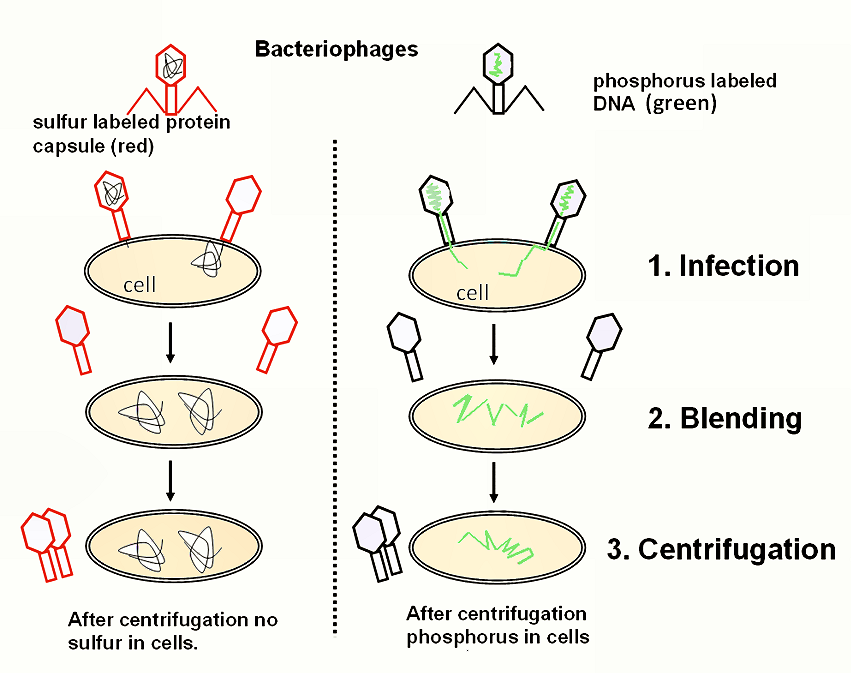
Explain how the results of the Hershey and Chase experiment supported the notion of nucleic acids as the genetic material.
AHL A1.2.14— Evidence from the Hershey–Chase experiment for DNA as the genetic material.
The molecule of heredity must be carried from generation to generation.
When Hershey and Chase demonstrated that radioactively tagged DNA is present across generations of bacteriophages and that radioactively tagged protein is not, they demonstrated that nucleic acids must be the genetic material.
